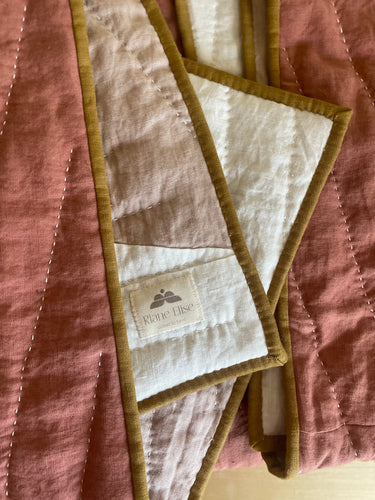Quilting is a craft that has stood the test of time, combining creativity and functionality to create beautiful pieces of art. One of the most critical steps in completing a quilt is the binding, which not only adds a polished finish but also helps protect the edges of your quilt. In this guide, we’ll explore the top tips for successful quilt binding that will elevate your sewing skills and ensure your quilts shine!
Understanding the Basics of Quilt Binding
Before diving into the tips, it’s essential to grasp the fundamental aspects of quilt binding. Quilt binding refers to the process of sewing strips of fabric to the edges of a quilt. This final touch not only secures the layers but also gives your quilt its finished look. There are various methods and styles of binding, but the basic concept remains the same.
Choosing the Right Binding Fabric
Your choice of fabric for binding can significantly impact the overall aesthetics of your quilt. Here are some tips for selecting the right fabric:
- Color Contrast: Choose a binding fabric that contrasts with the quilt top to create a striking edge.
- Matching the Backing: Alternatively, select a fabric that coordinates with the backing for a seamless look.
- Type of Fabric: Use a durable fabric that can withstand wear and tear to provide longevity for your quilt.
Preparing Your Quilt Binding
Once you’ve selected the fabric, the next step is preparing your quilt binding. Ensure the following:
Cutting Your Binding Strips
Cut your fabric into strips, the conventional width for quilt binding is typically 2.5 inches, but you can adjust this based on the thickness of your quilt layers or personal preference.
Joining the Strips
To create enough binding material, you may need to join several strips together. Align them at a right angle and sew diagonally from corner to corner. Trim the excess fabric, and press the seams open for a smoother finish.
Folding and Pressing Your Binding
Folding and pressing your binding properly is crucial, as it makes the sewing process more manageable.
Folding the Binding
To achieve a professional look, fold the binding strip in half lengthwise, wrong sides together. Press it with an iron to create a crease that will guide your stitching.
Using a Marker or Ruler
For precision, consider using a fabric marker or ruler to mark sewing lines for a straighter finish. Accuracy during this step sets the stage for a flawless binding process.
Attaching the Quilt Binding
Now that your binding is prepared, it’s time to attach it to the quilt.
Starting the Binding on a Side
Begin by placing the raw edges of your binding aligned with the edges of the quilt. Use clips or pins to hold the binding in place while you sew. Starting in the middle of one side creates a neat finish for the corners.
Using the Right Stitch Type
The kind of stitch you use will determine the binding’s accessibility and appearance. A straight stitch is commonly used for a classic look, while a zigzag stitch may offer extra durability.
Creating Perfect Corners
Mastering quilt binding includes knowing how to create perfect corners, as they can be tricky for many sewists.
The Mitered Corner Technique
This technique involves folding the binding at a 45-degree angle at the corners. Here’s how to achieve it:
- Sew your binding until you reach the corner.
- Stop sewing ¼ inch from the edge, backstitch, and lift the presser foot.
- Fold the binding up and away from the quilt, then fold it back down to create a triangle.
- Resume sewing along the next edge, holding the corner down securely.
Finishing the Binding
Once you’ve sewn around the quilt, the finishing touches are crucial.
Closing the Binding
To close the binding, you’ll need to join the two ends. Fold over the raw edge of the starting length and pin it in place. Trim the other end, allowing for a straight seam. Carefully sew the two ends together while preserving the binding’s width and crease.
Hand Stitching vs. Machine Stitching
You can finish your quilt binding by either hand stitching or machine stitching. Hand stitching creates an impeccable finish but requires patience. On the other hand, machine stitching is faster and can also provide a decorative touch if using a contrasting thread.
Tips for Troubleshooting Common Binding Problems
Even with the best preparation, you may encounter issues while binding that can lead to frustration. Here are some common problems and how to fix them:
Binding is Too Tight or Too Loose
If your binding feels too tight or too loose, it can affect the quilt’s overall appearance and functionality. Always measure your quilt edges accurately and adjust the fabric strips' width if necessary to achieve a balance.
Visible Thread on the Backside
If your thread appears on the back of the quilt, check the sewing tension and make appropriate adjustments. Test on a scrap piece before proceeding with the entire quilt.
Uneven Corners
Uneven corners can distract from your quilt’s beauty. Practice mitered corners on smaller projects before tackling larger quilts to perfect your technique.
Embracing Creativity in Quilt Binding
Quilt binding is not just about functionality but also an opportunity to express your creativity. Here are some ideas to inspire your next project:
Experiment with Colors and Patterns
Don’t hesitate to experiment with bold colors and patterns for your binding. Using a print or a contrasting color can create visual interest and highlight your quilt’s design.
Using Specialty Techniques
Consider trying specialty techniques, such as bias binding or using decorative stitches, to add a unique flair to your quilts. Integrating these techniques will set your quilts apart from the rest!
Your Next Steps into the World of Quilt Binding
Now that you’re armed with tips to successfully tackle quilt binding, it’s time to put your skills to the test! Whether you’re new to sewing or looking to refine your technique, practice will help you master the perfect finish for all your quilts. Remember, every quilt tells a story, and with the right binding, you’ll ensure that your story is beautifully told.
As you continue your quilting journey, embrace every challenge and triumph. The world of sewing is vast, filled with endless possibilities for creativity. Happy quilting!

